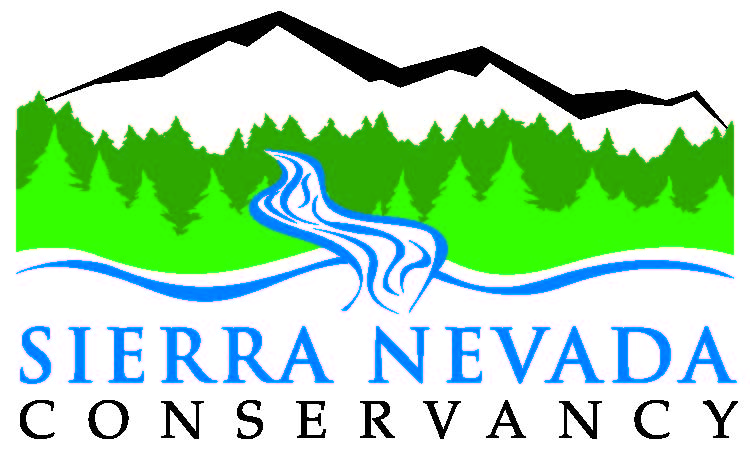Mountain Counties presents ‘The Complete Story’ of California Water Action Plan
By Roberta Long, MCWRA writer
The timing could not have been more perfect for the Mountain Counties Water Resources Association to talk about “The Complete Story” of the California Water Plan on Feb. 6. Just as the all-day meeting began at 9 a.m. at The Ridge Golf Club and Event Center in Auburn, the first drops of rain fell. They heralded the first of two storms over four days.
After three years of drought, the California Department of Water Resources snow survey on Jan. 29 measured the snow water equivalent at 25 percent of the state historical average. At Echo Summit, east of Sacramento, it was 12 percent. These two storms would add rainwater to northern California reservoirs, but do little to relieve drought conditions by adding to the snowpack on the Sierra Nevada Mountains. The storms were the type called a Pineapple Express, a variant of an atmospheric river.
With aerial technology and advanced scientific instruments, more is becoming known about atmospheric rivers. At the Oct. 5, 2012, Delta Stewardship Council meeting, then-Lead Scientist Peter Goodwin reported on a Science Program Brown Bag luncheon in 2011: Michael Dettinger, from the U.S. Geological Survey (USGS), Scripps Institute of Oceanography in La Jolla, described atmospheric rivers as “narrow corridors of concentrated moisture in the atmosphere. Within these corridors, moisture in the air flows like a river. The corridors are approximately 150-200 miles across, can be thousands of miles long, and are responsible for most of the horizontal transport of water vapor outside of the tropics.” They move with the weather and are present somewhere on the earth at any time.
A Pineapple Express is one type of strong atmospheric river, bringing large quantities of warm moisture over an extended period from the tropics near Hawaii to the U. S. West Coast.
California has the widest variation of precipitation of any area in the nation. On average, about 30-50 percent of annual precipitation occurs in a few atmospheric river events, making major contributions to the water supply in just a few days.
Most atmospheric rivers are weak, supplying beneficial rain or snow. A strong one can transport an amount of water vapor roughly equal to 7.5-15 times the water flowing through the mouth of the Mississippi River. A major event can cause extreme rainfall and flooding, causing catastrophic damage to life and property, disrupting travel and creating power outages.
The California Water Plan addresses the weather extremes, drought and flooding. The Complete Story at The Ridge included discussion of the Mountain Counties Overlay Area.
Pictures from the gallery MCWRA The Complete Story Video Link
Introduction
John Kingsbury, Mountain Counties Executive Director
Kingsbury told an audience of over 150 that the program was about the next step in improving California’s water. “You will hear it first-hand today,” he said as he thanked the 12 speakers for making time to participate.
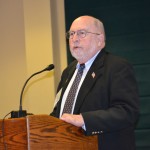 Bill George, Director, Mountain Counties Board
Bill George, Director, Mountain Counties Board
George described the California Water Plan as the guide for California’s water resource management and planning. For almost 60 years, the California Water Plan has been updated every five years. He said the Update 2013 extends to 2050, and reinforces the implementation of the Governor’s Water Action Plan.
California Water Plan, Update 2013
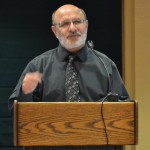 Kamyar Guivetchi, Statewide Integrated Water Management Manager, Department of Water Resources (DWR)
Kamyar Guivetchi, Statewide Integrated Water Management Manager, Department of Water Resources (DWR)
Guivetchi, mastermind of the Water Plan, explained Update 2013 took years of countless meetings working with hundreds of stakeholders. It aligns nearly 40 state agency plans.
He stressed the importance of the Mountain Counties Overlay Area. Because of the statewide significance of the natural resources in the region, DWR formed a Mountain Counties Core Writing Team for the Update 2013. Angela Avery, Regional Policy and Programs Manager, Sierra Nevada Conservancy, was the lead author of Update 2013 and John Kingsbury was a key participant, Guivetchi said. Kingsbury told the audience that, “I plan to carry a copy of the Mountain Counties Regional Report to each and every senator and assemblyperson at the Capitol to help them better understand the regional connection and importance to California.”
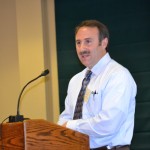 Paul J. Massera, P.E., Manager, Strategic Water Planning, DWR
Paul J. Massera, P.E., Manager, Strategic Water Planning, DWR
Massera said a “potpourri of stakeholders participated” in Update 2013 over a period of five years, including John Kingsbury. The report displays a storyline of water in California to the present day and beyond. The Governor’s Office released the Update 2013 on Oct. 30, 2014. Massera said the document is 3,500 pages. It has three themes:
1. Commit to integrated water management
2. Strengthen government agency alignment
3. Invest in innovation and infrastructure
If nothing else, there are five core messages that every Californian should understand:
1. Water is the essence of life for California
2. California’s complex water system is in crisis
3. A diverse set of actions and investment strategies is necessary
4. Solutions require integration, alignment and investment
5. We all have a role to play in securing our future
The objectives of Update 2013 are integrated with the 10 priority actions of the Governor’s Action Plan.
Update 2013 contains a quantification of flood risk for the first time. It addresses forest and watershed management. It sets out the ratios of how water is supplied and how it is used. Massera said future funding will be a combination of regional and state dollars. Federal investment will be minimal at best.
The impacts of floods and droughts can be managed, Massera said. We need to act now, he emphasized. Seven million people and $600 billion in assets are in floodplains.
Mountain Counties Overlay Regional Report
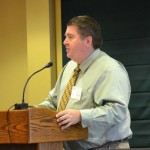 Lew Moeller, Program Manager, California Water Plan, DWR
Lew Moeller, Program Manager, California Water Plan, DWR
Moeller said the Mountain Counties Area regional report was created for the first time in 2005 to inform decision-makers about the value and characteristics of the natural infrastructure and cultural resources in the area, principally, water. It moves the question of California’s water reliability from the Central Valley and California’s cities up to the watersheds that are the source of more than 40 percent of the state’s developed water supply. The larger Sierra Nevada region is the source of 60 percent.
The California Water Plan includes reports on 10 hydrologic regions. In addition, there are reports on studies of two overlay areas of statewide significance. The overlay areas cross boundaries from one hydrologic region to another, and have common water management conditions.
The Mountain Counties Overlay Area is significant as it spans three hydrologic regions and includes all or part of 16 counties.
Some of the shared conditions in the overlay area are that homes and farms are spread out, making water distribution more expensive. Small customer bases create challenges for maintaining or expanding reservoirs, treatment plants and equipment, not to mention the lack of ability to apply for grants. Catastrophic fires, such as the King Fire on the Eldorado National Forest in 2014 that burned 97,717 acres and the Rim Fire on the Stanislaus National Forest that burned 257,314 acres, leave soils sterilized and create sediment runoff that settles in reservoirs and is carried downstream. The probability of reduced snow packs in future years means less reliance on spring melts to provide water during the irrigation season. There are no groundwater basins. Wells drilled in fractured rock are unreliable. Towns and villages in the Mountain Counties area are economically disadvantaged because they are dependent on seasonal recreation and tourism businesses. Many of the reservoirs in the Mountain Counties were constructed to serve downstream users. As a consequence, water supplies associated with those reservoirs are unavailable for local use.
Looking ahead, Moeller said one answer to lack of financial capacity is to integrate planning. There are several Integrated Regional Water Management Plans that have received joint funding. With thousands of feet of elevation change, small hydroelectric facilities can add revenue to local agencies while helping meet the State’s clean air objectives. Developing biomass and related wood products facilities will reduce the number and impacts of large fires, create local jobs, restore the ability of forests to contribute to cleaner air, provide for wildlife, and help restore forests to a healthy state for trees and water.
The report calls for a comprehensive long-term watershed protection program. The future reliability of California’s statewide water supply begins with protection of the source in the Sierra Nevada watershed, Moeller said.
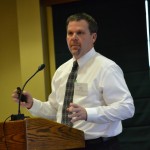 Gary Lippner, P.E., Chief Regional Planning and Coordination Branch, Division of Integrated Regional Water Management, DWR
Gary Lippner, P.E., Chief Regional Planning and Coordination Branch, Division of Integrated Regional Water Management, DWR
Lippner continued Moeller’s message, saying the state agency people need to work more with locals. He noted the design team engaged with passion. “The result was a holistic and comprehensive report,” he said. The goal is to increase regional self-reliance and integrated water management.
Water management in the Mountain Counties requires special considerations. Lippner said the effects of climate change are most noticeable in the mountains. He mentioned the communities of place, typical in the Mountain Counties, are not the same as communities of interest, where people associate for a common topic, such as downstream water rights or recreational water or forestland use.
Only about 40 percent of the lands are privately owned. The waters flow from sources on public lands. Tribal councils manage a small, but important, percentage of the lands.
Lippner said building and maintaining strong collaborative partnerships will be necessary in the future.
State of the Sierra Nevada’s Forest and Watershed Improvement Program
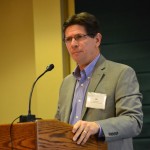 Jim Branham, Executive Officer, Sierra Nevada Conservancy
Jim Branham, Executive Officer, Sierra Nevada Conservancy
Branham began by referring to a film called “The Big Burn” that was shown on Jan. 29 as part of the American Experience series on the Public Broadcasting System. Over a weekend in August 1910, hundreds of wildfires burned more than 3 million acres in the Bitterroot Mountains that straddle the Montana-Idaho border. Temperatures reached almost 2000 degrees. At least 100 people, including firefighters, died from falling trees, flames and smoke inhalation. It was beyond the ability of the newly formed, five-year-old U.S. Forest Service to mount a response.
A century later, our forests are again in crisis, said Branham. Not all fires are bad. Some species of trees need fire to reproduce. Smaller fires at regular intervals keep forests healthy. Without them, fuels have built up on forest floors over decades, making the forests vulnerable to catastrophic fires caused by lightning or human activities. Multiple years of drought exacerbate the conditions.
Fire intensity is increasing. More land burned between 2000-2015 than the entire seven previous decades. The models were not able to predict the trend.
All the benefits are at risk, he said. The entire Sierra Nevada region is the origin for more than 60 percent of California’s developed water supply. It is the primary source of fresh water flowing into the Sacramento-San Joaquin Delta. Healthy forests store, or sequester, massive amounts of carbon. The Rim Fire released greenhouse gas emissions equal to what 2.3 million vehicles would release in a year. Forests are home to hundreds of plant and animal species. California’s forests provide world-class recreation to millions of visitors from around the world. They are major producers of wood products and hydroelectric power.
Large-scale fires are expensive to fight and expensive to heal. In California, 6 to 9 million acres need restoration.
Tree spacing affects water supply as well as fire management. If the trees are close together, snowfall does not reach the ground. If the trees are far apart, snow melts too early in the year.
Reversing a longstanding policy of forest management is not easy. Branham cited impediments such as insufficient funding and resources, lack of biomass wood processing infrastructure, lengthy and complex planning processes, learning to use fire as a management tool, and developing more contracting to maximize local benefits to forest communities. He quoted a Tuolumne County supervisor who complained that the leading economic driver in his community is meth.
Branham said conflict does not work. He cited the title of a country song, “A Little Less Talk and a Lot More Action.” In keeping with that theme, the Sierra Nevada Conservancy and the U.S. Forest Service are launching the Sierra Nevada Watershed Improvement Program.
California Water Action Plan Implementation
 Gary Bardini, Deputy Director, DWR
Gary Bardini, Deputy Director, DWR
Bardini continued the action motif in his presentation on sustainable water management. “We have a plan,” he said. “We need action. We need to lead the way. We need innovation. No more status quo. We need to break through.”
The Implementation Report 2014-2018, prepared for the legislature, is available for download at: http://resources.ca.gov/california_water_action_plan. The report contains A Roadmap for Sustainability, Drought Response and a Foundation for Future work, The Next Four Years and Beyond, and Financing.
Of the 10 priority actions in the California Water Action Plan, five relate to Mountain Counties.
2. Increase regional self-reliance and integrated water management across all levels of government
4. Protect and restore important ecosystems
5. Manage and prepare for dry periods
6. Expand water storage capacity and improve groundwater management
10. Identify sustainable and integrated financing opportunities
Bardini said DWR and the State Water Board will have a prominent role in developing regulations, providing grants and local assistance. The 2015-16 state budget includes $1.8 billion to implement the plan. The estimated cost of the plan for the next three years is $5 billion. Proposition 1, passed last November, can provide $400 million over a 10-year period. The balance will need to be provided by the state general fund and local and federal sources.
The 11 Integrated Regional Water Management (IRWM) groups in the Mountain Counties Overlay Area have been awarded $51 million for implementation projects so far, using Proposition 84 and 1E funds. The balance of Proposition 84 funds, $220 million, will be disbursed in a final round this year.
Proposition 1 contains $2.7 billion for the public benefits of water storage, including groundwater, reservoir reoperation and conjunctive use. The California Water Commission is the granting agency. The maximum state share for public benefit of a project is 50 percent. Ecosystem benefits must be 50 percent of the public benefit share. Other benefits eligible for funding are water quality improvement, flood control, emergency response, and recreation.
He said the Sustainable Groundwater Management Act of 2014 is based on managing groundwater at the local level with state assistance and oversight.
Bardini summarized his message: “Everyone has to be willing to take risk, to do what we haven’t done. We are at a breakthrough, not a crossroads.”
Special guest appearance
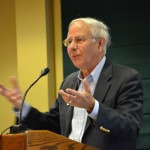 Dave Breninger, Placer County Water Agency (PCWA) General Manager
Dave Breninger, Placer County Water Agency (PCWA) General Manager
Kingsbury interrupted the scheduled program to invite Dave Breninger to make some impromptu remarks. Breninger had announced his retirement as general manager of Placer County Water Agency on Oct. 30, 2014, effective March 6, 2015. He is recognized as a statewide leader on water issues and a strong advocate for mountain counties water interests.
“Everything builds on itself going forward,” said Breninger. He remarked that he had been working on the American River Project for 23 years, his entire tenure at PCWA. He said, “Downstream should look more at the watershed. The state is becoming more active in the mountain counties.
Time to celebrate
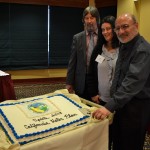 To celebrate completion of Update 2013 and the Mountain Counties Regional Report, Kingsbury invited Angela Avery to join him and invited Kamyar Guivetchi to cut a cake that was later served as dessert. Angela Avery said that DWR went out of its way to work with locals. She added that she hopes the report will prove valuable and go forward.
To celebrate completion of Update 2013 and the Mountain Counties Regional Report, Kingsbury invited Angela Avery to join him and invited Kamyar Guivetchi to cut a cake that was later served as dessert. Angela Avery said that DWR went out of its way to work with locals. She added that she hopes the report will prove valuable and go forward.
Kingsbury responded, “We (Mountain Counties) look forward to working with you to implement the plan.
Keynote speaker
Nielsen was first elected to the California State Senate in 1978, where he served until 1990. He was the Republican leader from 1983 to 1987. Afterward he served on the Agriculture Labor Relations Board. He was appointed to the Board of Parole and Prison terms in 1992, and was chairman from 1993 to 2000. In 2012, Nielsen was re-elected to the Senate, representing the 4th district. The 4th Senate district borders Shasta County on the north and extends south on both sides of Interstate 5 into Rancho Cordova. Several Mountain Counties are in the 4th Senate District. Nielsen lives in Gerber, Tehama County, southeast of Red Bluff, where he is a rancher.
Nielsen said he represents the Lake Oroville area. It was the last big surface storage project built in California, he added. Oroville Dam opened in 1968 for the purpose of providing irrigation water, flood control and hydroelectric power. Nielsen echoed Breninger’s statement that until recently the water source areas in the mountain counties were left out of consideration. “Water was Delta-centric,” said Nielsen. Our water future was not predicted on sharing scarcity or providing for the needs of our grandchildren. He expressed concern that area-of-origin protections could be eroded through the 2009 Sacramento-San Joaquin Delta Reform Act.
Nielsen is a vigorous supporter of the Sites Reservoir in Colusa County. Sites is one of three projects that could be funded by Proposition 1 to add surface storage to the state. The three were investigated by the CALFED program and found worthy of further study. Besides Sites, the other two are raising the height of Shasta Dam and building Temperance Flat Dam.
Sites is a large off-stream reservoir west of the Sacramento River north of the Delta. The dam would provide hydropower. Our goal is to be turning dirt in one year, Nielsen said. He also advocated for the Temperance Flat reservoir in Fresno and Madera counties.
Nielsen spoke about forest and wildlands. He said he is working on the issue of runoff. Sediment control is important to ranchers and farmers.
“Savor your success,” he encouraged. “Stay informed and involved.”
Panel: Proposition 1-The Water Bond
Gary Bardini, Deputy Director, DWR; Jim Branham, Executive Officer, Sierra Nevada Conservancy; Daniel Curtin, Commissioner, California Water Commission; John Donnelly, Executive Director, California Wildlife Conservation Board; Steven Moore, P.E., Board Member, State Water Resources Control Board; Sandy Morey, Deputy Director, California Department of Fish and Wildlife; Dan Ray, Executive Officer, Delta Stewardship Council
The afternoon panel, which included seven state agency officials, provided their views and perspective on Proposition 1 funding sources, followed by a series of questions posed by Kingsbury. Questions from the audience followed.
“The California Water Plan, Update 2013, and the Governor’s Action Plan, along with the passage of Proposition 1 (water bond) on last November’s ballot mark an important milestone to improve California’s water outlook. Now, the focus is how to allocate the $7.545 billion contained in the bond,” said Kingsbury.
“As we all know, the ultimate value and effectiveness of the bond will depend on how it is implemented and how the funds are allocated and spent. The very difficult challenge for these seven state agencies will be to effectively allocate the water bond money from the key funding areas into a holistic statewide implementation program”, said Kingsbury.
Some of the highlights are:
 Gary Bardini began with a cautionary note. He said the $7.5 billion bond is a good next step investment, but this time the government will be frugal. It will be based on the Governor’s Action Plan. It took several tries to get a bond measure on the ballot, and was reduced significantly from the original proposal. California has spent $15 billion over 20 years. How much more can we continue to spend, he submitted. Government is not the only source. We need more stable financing, he said.
Gary Bardini began with a cautionary note. He said the $7.5 billion bond is a good next step investment, but this time the government will be frugal. It will be based on the Governor’s Action Plan. It took several tries to get a bond measure on the ballot, and was reduced significantly from the original proposal. California has spent $15 billion over 20 years. How much more can we continue to spend, he submitted. Government is not the only source. We need more stable financing, he said.
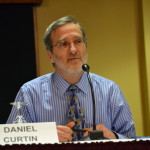 Daniel Curtin started by commending Nielsen. He brings an air of civility to the floor and to debates that has been lacking recently, he said. However, Nielsen’s hope of breaking ground on Sites reservoir next year is not realistic. There will be no allocations until Sept. 15, 2016. The California Water Commission is planning to hold meetings outside the capitol in the fall. Whatever allocations are made will have to be matched in an equal amount.
Daniel Curtin started by commending Nielsen. He brings an air of civility to the floor and to debates that has been lacking recently, he said. However, Nielsen’s hope of breaking ground on Sites reservoir next year is not realistic. There will be no allocations until Sept. 15, 2016. The California Water Commission is planning to hold meetings outside the capitol in the fall. Whatever allocations are made will have to be matched in an equal amount.
Curtin said that upper watershed management projects qualify, as do local storage projects. The bond gives us a new approach, he said. Water, forestry, air quality, and biomass are all linked, and regulated by different agencies. All the agencies have a pot of money.
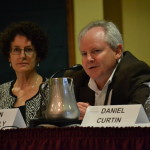 John Donnelly said the California Wildlife Conservation Board (CWF) was established in 1947. It is a three-member independent board. Its primary responsibilities are to select, authorize and allocate funds for the purchase of land and waters suitable for recreation purposes and the preservation, protection and restoration of wildlife habitat. CWF funds 11 programs from different bond measures: riparian, forest, wetlands, agricultural lands, oaks, habitat enhancement, acquisition, tax credit, public access and monitoring. Applications are accepted for habitat restoration projects and for improvements to public access facilities on a continuous basis.
John Donnelly said the California Wildlife Conservation Board (CWF) was established in 1947. It is a three-member independent board. Its primary responsibilities are to select, authorize and allocate funds for the purchase of land and waters suitable for recreation purposes and the preservation, protection and restoration of wildlife habitat. CWF funds 11 programs from different bond measures: riparian, forest, wetlands, agricultural lands, oaks, habitat enhancement, acquisition, tax credit, public access and monitoring. Applications are accepted for habitat restoration projects and for improvements to public access facilities on a continuous basis.
 Sandy Morey said the California Department of Fish and Wildlife (DFW) has two pots of money from the Proposition 1 bond. They will fund multi-benefit ecosystem and watershed protection and restoration projects at a rate of $31 million a year for 10 years. The Watershed Restoration
Sandy Morey said the California Department of Fish and Wildlife (DFW) has two pots of money from the Proposition 1 bond. They will fund multi-benefit ecosystem and watershed protection and restoration projects at a rate of $31 million a year for 10 years. The Watershed Restoration
Grant Program, with a total of $285 million, will focus on water quality, river, and watershed protection and restoration projects of statewide importance outside the Delta. The Delta Water Quality and Ecosystem Restoration Grant Program, with $87.5 million, will focus on water quality, ecosystem restoration and fish protection facilities that benefit the Delta. DFW will be looking at meadows, forests and degraded streams. The focus will be on outcomes, said Morey. Co-benefits are water storage, water supply and water quality.
 Steven Moore mentioned the importance of resource stewardship in times of drought. “Thank you, Mountain Counties,” he said, for water saved through conservation.
Steven Moore mentioned the importance of resource stewardship in times of drought. “Thank you, Mountain Counties,” he said, for water saved through conservation.
He said the State Water Resources Control Board (SWRCB) has an accelerated process for granting five pots of money. The categories are: small wastewater projects, safe drinking water, recycled water, storm water, groundwater cleanup. On the SWRCB website, there is one application for everything. “The Complete Story” begins with a complete application, he said.
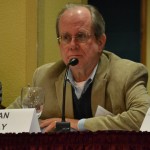 Dan Ray said a goal of the Delta Stewardship Council (DSC) is to diversify water supplies so Californians don’t have to be so dependent on waters that flow through the Delta. “We are breaking ground on projects that were planned 10 years ago,” he said. The Central Valley Flood Protection Plan, which will be funded through Proposition 1E, will be a benefit to upstream users, allowing more water to be reserved for upstream use. Levee priorities will also be addressed.
Dan Ray said a goal of the Delta Stewardship Council (DSC) is to diversify water supplies so Californians don’t have to be so dependent on waters that flow through the Delta. “We are breaking ground on projects that were planned 10 years ago,” he said. The Central Valley Flood Protection Plan, which will be funded through Proposition 1E, will be a benefit to upstream users, allowing more water to be reserved for upstream use. Levee priorities will also be addressed.
The Delta Plan, including the Science Plan, is incorporated into the Water Action Plan. The Interagency Integration Committee, with the Science Program, is tracking outcomes. This shortens the 10-12 year lag time experienced in the past.
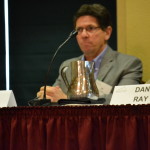 Jim Branham said the Sierra Nevada Conservancy (SNC) receives $25 million, or one-half of one percent of the $7.5 billion Proposition 1 funds. SNC is a state agency created in 2004. Critical issues SNC is working on are: California’s primary watershed, healthy forests, bioenergy, and abandoned mines. The focus of the Proposition 1 grants is healthy forests. The $25 million will be released over a period of 10 years, with $10 million released each of the first two years. Draft guidelines are on the website. Public comments will be accepted through March 27.
Jim Branham said the Sierra Nevada Conservancy (SNC) receives $25 million, or one-half of one percent of the $7.5 billion Proposition 1 funds. SNC is a state agency created in 2004. Critical issues SNC is working on are: California’s primary watershed, healthy forests, bioenergy, and abandoned mines. The focus of the Proposition 1 grants is healthy forests. The $25 million will be released over a period of 10 years, with $10 million released each of the first two years. Draft guidelines are on the website. Public comments will be accepted through March 27.
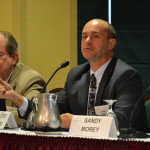 Steven Moore encapsulated the discussion, saying, “We want to make the water bond workable for all Californians.”
Steven Moore encapsulated the discussion, saying, “We want to make the water bond workable for all Californians.”
Acknowledgements
Kingsbury acknowledged and thanked the supporters, participants and guests at the day-long event. Placer County Water Agency was host. Parjana and Parjana Distribution underwrote the video programming. Sierra Nevada Conservancy, EN2 Resources, Inc., Cardno, and West Consultants, Inc. sponsored the program.
“Outside, the rain continued.”



